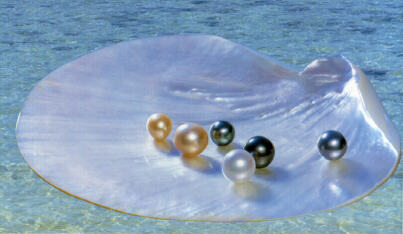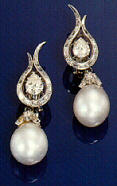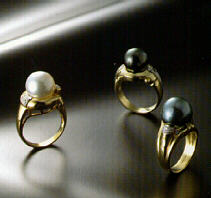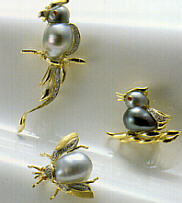
 |
![]()
 Because of its scarcity, larger size and beauty, the South Sea cultured pearl is treasured as "the Queen of Pearls" and "The Pearl of Queens."
Because of its scarcity, larger size and beauty, the South Sea cultured pearl is treasured as "the Queen of Pearls" and "The Pearl of Queens."
South Sea cultured pearls may be easily distinguished from their Akoya counterparts by their larger size. Generally speaking, where the Akoya stops in size, the South Sea pearl begins. The Akoya cultured pearl usually ranges from 2mm to 9mm, the South Sea cultured pearl from 9mm to 16mm or, in very exceptional cases, even larger.
There are two basic groups of South Sea cultured Pearls: white and dark.
The White Group
 White South Sea cultured pearls are mainly produced by the pinctada maxima, among the largest of the thirty or so species of pearl oysters found worldwide. Its shell can grow to a diameter of 25-30cm, and it may weigh up to 5.5kg. This giant mollusk produces a correspondingly large pearl, and deposits a thicker nacreous layer than most other oysters.
White South Sea cultured pearls are mainly produced by the pinctada maxima, among the largest of the thirty or so species of pearl oysters found worldwide. Its shell can grow to a diameter of 25-30cm, and it may weigh up to 5.5kg. This giant mollusk produces a correspondingly large pearl, and deposits a thicker nacreous layer than most other oysters.
The pinctada maxima, generally found in northern Australian waters is often called "silver-lipped" or "white-lipped" because the edges if its inner shell are a gleaming silvery white. Cultivated since the late 1950's, Australian South Sea pearls are noted for their silvery shades often shot through with bluish or metallic tints.
The Dark Group
 | The dark group of South Sea cultured pearls derives from large, black-lipped pearl oysters scientifically known as pinctada margaritifera which live in the waters surrounding Tahiti.
The inside edges of this oyster are characterized by a blackish-green belt with traces of pink bursting through. Its nacre is usually a lustrous deep, dark green. Because of these characteristics, the bulk of any crop will inevitably contain bluish, grayish or brown-black pearls. |
 The value of any South Sea cultured pearl varies, as with the Akoya, according to its size, color, shape, luster, texture, thickness of its coating and surface smoothness.
The value of any South Sea cultured pearl varies, as with the Akoya, according to its size, color, shape, luster, texture, thickness of its coating and surface smoothness.
A wide variety of colors and tints may be found in the cultured pearls of both the white and the dark groups. Distinctive coloration is one reason why South Sea pearls are so highly prized. Their shapes, too, differ as only a very few are perfectly round.
Because of their relative scarcity, South Sea cultured pearls command high prices throughout the world. It is an accepted rule of thumb that a single South Sea cultured pearl may cost about the same as an entire Akoya choker.